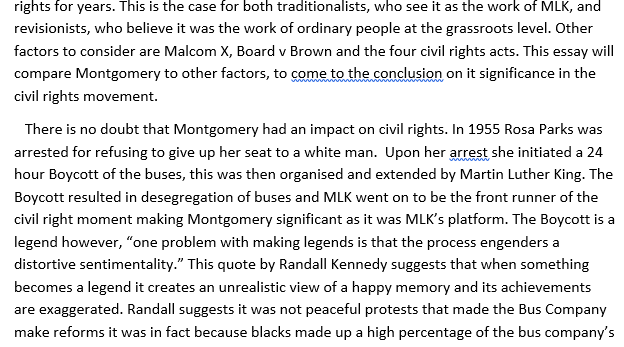How to Write a Conclusion for History Coursework

If you’re looking for help on how to write a conclusion for history coursework, then look no further. Here are some helpful tips. The first step is to outline the main points. These should be discussed in the body of the essay. After you have written the body of the essay, it’s time to develop the conclusion. Use your main points to make the connection between the main points and the main idea of the essay.
Introduction
The introduction to a history coursework paper will have a thesis statement that describes the area of interest and the context in which the question is placed. The introduction should sound catchy and appealing to the reader. The body of the paper should focus on historical events and provide evidence and facts to back up the thesis statement. It can include information about relevant historical policies or statistics. This part of the paper should be structured like an essay, presenting the reader with the information they are looking for.
In addition, the introduction to a history coursework paper should be focused and clear. The question should clearly state the subject of discussion and the perspective that is argued for. Then, it should make a recommendation of what should be done. The final line of the paper should connect back to the introduction to give readers a sense of closure. Once this is done, the introduction to a history coursework paper will be completed.
Also Read: How Many Pages is 3000 Words Double Spaced
An introduction to a history paper is a vital part of academic writing. While it might seem like an unnecessary addition, it serves an important function. Unlike an introduction that is merely an afterthought, the introduction plays a pivotal role in a paper’s argument. Here, you must make sure the introduction captures the interest of the audience and provides them with enough facts and statistics to support the thesis.
In the introduction to a history coursework paper, you must make sure you have made sure to establish the thesis statement in the body. Once you have this information, you can begin writing the conclusion. After you have done this, the conclusion must summarize the main arguments and explain why the ideas are important in the subject area. An introduction should be predictable, so your reader will know exactly what to expect from the paper. So, if you want to impress your teacher, a good introduction is a must.
New ideas in conclusion
Writing a history coursework conclusion is tricky. There is so much content to include that it can be challenging to choose just one idea. In many cases, writing a history coursework conclusion will require you to make some difficult decisions, such as which ideas to include and which ones to avoid. The conclusion should also be the last line of the coursework, so it should tie back to the introduction and give your audience a sense of closure.
Word count
When writing history essays, it is crucial that you avoid generalisations. This is a common mistake in any essay, but is particularly damaging in history. In a generalisation, students draw general conclusions from examples that do not apply to broader groups. History is rarely simple, and human society and people are rarely black and white. Avoid generalisations and use examples in your essay to support your arguments. Checking the work of previous students’ history essays can help you avoid making generalised statements in your own essay.
A good conclusion should be a summation of your entire program work, and should not be longer than two to three pages. It should also not include unnecessary details. Many students struggle with drafting their conclusion. This phase is often the most difficult, so it’s important to understand how to write it properly. To help you, we have compiled a list of tips for writing a conclusion in history coursework.
The introduction section of your coursework should be focused on a historic event and support it with relevant policies and information. The body of your essay should also clearly address the question asked by your teacher. During the writing process, you should present different interpretations and explain which ones are more credible. Make sure that you support your judgment with evidence to make your work stand out from other students’. When writing a history coursework, remember that it should be formatted in an essay format and proofread thoroughly.
Clarity of tone
When you write a conclusion for your history coursework, the most important thing to focus on is clarity of tone. There are several different types of tone: formal, amused, or dispassionate. You may treat your readers as intellectual inferiors or as friends. Or, you may treat yourself ironically or with amused detachment. The possibilities are endless. But to make sure your conclusion is effective, consider some of the following tips:
Avoid using jargon. Scholars rely heavily on precise language and words. Don’t use jargon or overused terms. Keep the tone of your work as professional and academic as possible. Use punctuation marks sparingly and judiciously. Exclamation points are rarely appropriate for writing a conclusion, as they can come across as unsophisticated or overly enthusiastic. Use hyphens only for compound phrases, dashes for explanatory comments, and semi-colons for pauses between sentences.
Structure
The structure of a conclusion for history coursework depends on the thesis statement that you have stated in the introduction. It should describe your area of interest and explain the context of the question. Try to make it as interesting as possible. The introduction should also include facts and evidence that supports your thesis. You can also include relevant historical statistics or policies that relate to your topic. In the conclusion, you can restate your thesis statement and justify your analysis.
The body of the essay should start with an introduction that highlights the main points of the essay and supports them with a supporting sentence or two. The conclusion should not introduce new ideas, as this is the purpose of the introduction. Instead, it should simply suggest new things that are related to the subject. In addition, the last line of the coursework should be the closing sentence. The closing sentence should connect back to the introduction and give the reader a sense of closure.




Leave a Reply